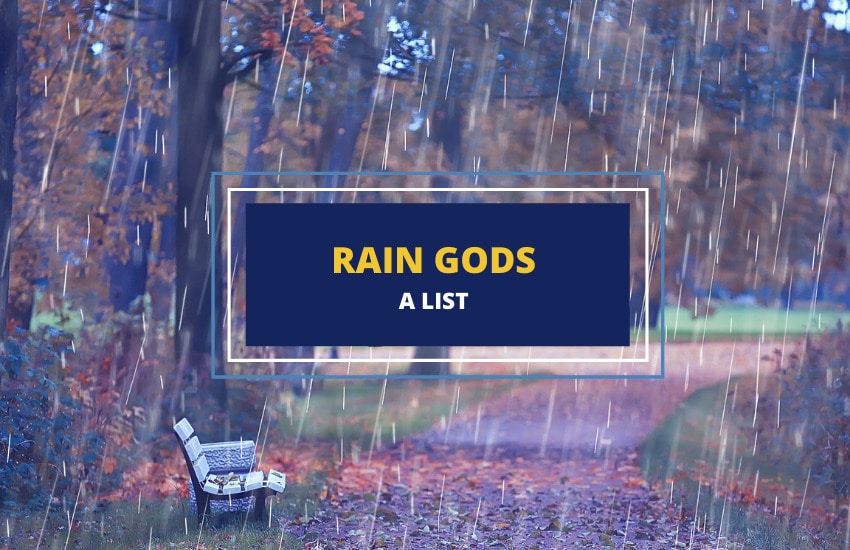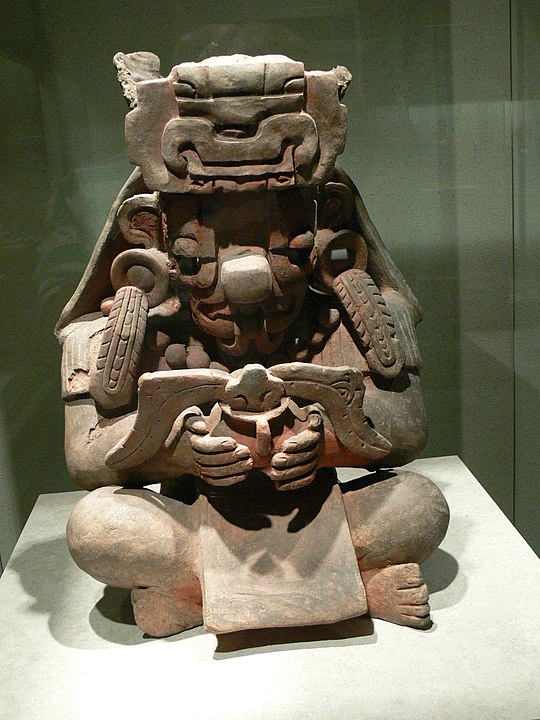
Table of Contents
For thousands of years, many polytheistic religions attributed natural phenomena to the work of gods and goddesses. The life-giving rains were seen as gifts from divinities, especially by societies that depended on agriculture, while periods of drought were thought to be a sign of their anger. Here’s a look at rain gods from different time periods in history.
Ishkur
The Sumerian god of rain and thunder, Ishkur was worshipped around 3500 BCE until 1750 BCE in the city of Karkara. In prehistoric times, he was perceived to be a lion or a bull, and sometimes portrayed as a warrior riding in a chariot, bringing rainfall and hailstones. In one Sumerian hymn, Ishkur destroys the rebellious land like the wind, and is responsible for the so-called silver lock of the heart of heaven.
Ninurta
Also known as Ningirsu, Ninurta was the Mesopotamian god of rainstorms and thunderstorms. He was worshipped around 3500 BCE to 200 BCE, especially in the Lagash region where Gudea built a sanctuary in his honor, the Eninnu. He also had a temple in Nippur, the E-padun-tila.
As a Sumerian god of farmers, Ninurta was also identified with the plough. His earliest name was Imdugud, which meant rain cloud. He was symbolized by a lion-headed eagle and his weapon of choice was the mace Sarur. He was mentioned in temple hymns, as well as in the Epic of Anzu and the Myth of Atrahasis.
Tefnut
The Egyptian goddess of rain and moisture, Tefnut was responsible for maintaining life, making her one of the most important deities in the religion called the Great Ennead of Heliopolis. She’s commonly depicted with a head of a lioness with pointed ears, wearing a solar disk on her head with cobra on each side. In one myth, the goddess became furious and took all the moisture and rain with her, so the lands of Egypt dried up.
Adad
Derived from the older Sumerian Ishkur, Adad was the Babylonian and Assyrian god worshipped around 1900 BCE or earlier to 200 BCE. The name Adad is believed to have been brought into Mesopotamia by Western Semites or Amorites. In the Babylonian epic of the Great Flood, the Atrahasis, he causes the first drought and famine, as well as the flood which was to destroy mankind.
During the Neo-Assyrian period, Adad enjoyed a cult following in Kurbaʾil and Mari, now modern-day Syria. His sanctuary in Assur, the House which Hears Prayers, was converted into a double temple of Adad and Anu by king Shamshi-Adad I. He was also invoked to bring rains from heaven and protect crops from storms.
Baal
One of the most important deities in Canaanite religion, Baal may have originated as a god of rain and storms, and later became a vegetation deity concerned with fertility of the land. He was also popular in Egypt from the later New Kingdom around 1400 BCE to its end in 1075 BCE. He was mentioned in Ugaritic creation texts, particularly the legends of Baal and Mot, and Baal and Anat, as well as in the Vetus Testamentum.
Indra
One of the most important of the Vedic deities, Indra was the bringer of rain and thunder, worshipped around 1500 BCE. The Rigveda identifies him with the bull, but in sculptures and paintings, he’s commonly depicted riding his white elephant, Airavata. In later Hinduism, he’s no longer worshipped but only plays mythological roles as the king of gods, and a god of rain. He also appears in the Sanskrit epic Mahabharata as the father of the hero Arjuna.
Zeus
The chief deity of the Greek pantheon, Zeus was the sky god who ruled the clouds and rains, and brought thunder and lightning. He was worshipped around 800 BCE or earlier until Christianization around 400 CE throughout Greece. He had an oracle at Dodona, where priests interpreted the babbling of water from the spring and the sounds from the wind.
In Hesiod’s Theogony and Homer’s Iliad, Zeus exercises his anger by sending violent rainstorms. He was also worshipped in the Greek island-state of Aegina. According to the localized myth, there was once a massive drought, so the native hero Aiakos prayed to Zeus to make rain for humanity. It’s even said that the parents of Aiakos were Zeus and Aegina, a nymph who was the embodiment of the island.
Jupiter
The Roman counterpart of Zeus, Jupiter controlled the weather, sent rains and brought down fearful storms. He was worshipped around 400 BCE to 400 CE throughout Rome, especially at the beginning of the planting and harvest seasons.
As a god of rain, Jupiter had a festival dedicated to him, called aquoelicium. The priests or pontifices brought the rainstone called lapis manalis into Rome from the temple of Mars, and people followed the procession with bare feet.
Chac
The Maya god of rain, Chac was closely associated with agriculture and fertility. Unlike other rain gods, he was thought to live within the earth. In ancient art, his mouth is often portrayed as a gaping cave opening. During the post-Classic times, prayers and human sacrifices were offered to him. Like other Maya gods, the rain god also appeared as four gods called Chacs, which later became linked with Christian saints.
Apu Illapu
Also known as Illapa or Ilyapa, Apu Illapu was the rain god of the Inca religion. His temples were usually built on high structures, and people prayed to him to protect them from drought. Sometimes, human sacrifices were even made for him. After the Spanish conquest, the rain god became linked with Saint James, the patron saint of Spain.
Tlaloc
The Aztec rain god Tlaloc was represented wearing a peculiar mask, with long fangs and goggle eyes. He was worshipped around 750 CE to 1500 CE, mainly at Tenochtitlan, Teotihuacan, and Tula. The Aztecs believed he could send out rain or provoke drought, so he was also feared. He also unleashed devastating hurricanes and hurled lightning upon the earth.
The Aztecs would sacrifice victims to the rain god to ensure that he was appeased and kept content. At Tula, Hidalgo, chacmools, or human sculptures holding dishes, were found, thought to have held human hearts for Tlaloc. He was even appeased by sacrificing large numbers of children during the first month, Atlcaualo, and the third month, Tozoztontli. By the sixth month, Etzalqualiztli, rain priests used fog rattles and bathed in the lake to invoke rain.
Cocijo

The Zapotec god of rain and lightning, Cocijo is depicted having a human body with jaguar features and a forked serpent tongue. He was worshipped by the cloud people in the Valley of Oaxaca. Like other Mesoamerican cultures, the Zapotecs depended on agriculture, so they offered prayers and sacrifices to the rain god in order to end droughts or bring fertility to the land.
Tó Neinilii
Tó Neinilii was the rain god of the Navajo people, the Native Americans who lived in the Southwest, now modern-day Arizona, New Mexico, and Utah. As the Lord of the Celestial Waters, he was thought to carry waters for the other deities in the pantheon, as well as spread them to the four cardinal directions. The rain god was commonly depicted wearing a blue mask with a fringe of hair and a collar.
Wrapping Up
Rain gods have been worshipped for centuries by a number of different cultures and religions. Their cults prevailed in the East, as well as in parts of Europe, Africa and the Americas. Since their intervention is thought to benefit or harm humankind, prayers and offerings were given to them. These deities remain associated with both life-giving and destructive properties of rain and flood.








